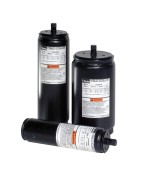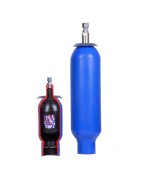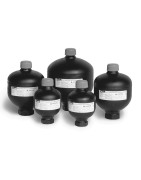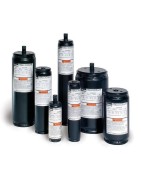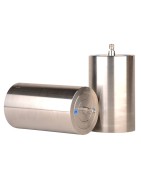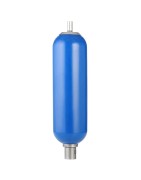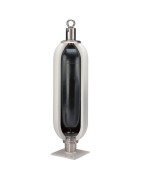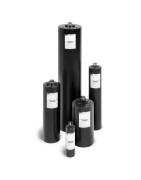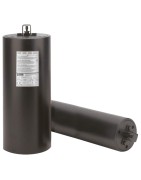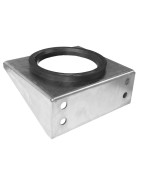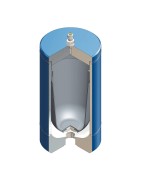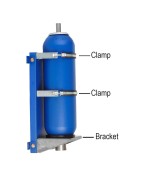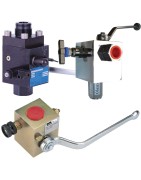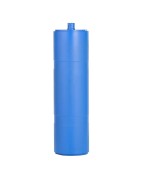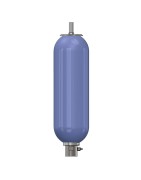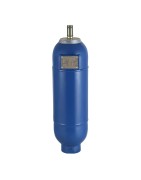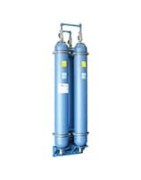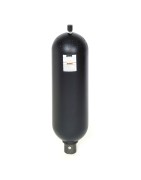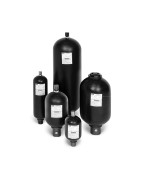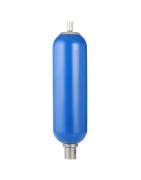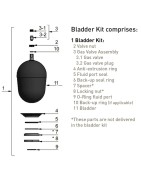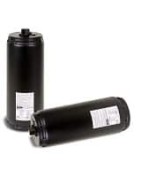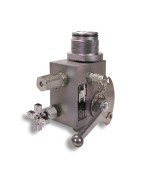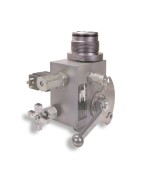Akumulatory hydrauliczne
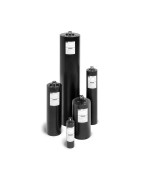
-
Akumulator tłokowy z zaciskaną nasadką — seria ACP (Europa)
Akumulatory tłokowe ACP mają opatentowaną konstrukcję z zaciskami, która zapewnia wysoką wytrzymałość połączenia nasadek ze stalowymi rurkami oraz doskonałą trwałość zmęczeniową. Rurka ze stali węglowej wysokiej klasy oraz materiał nasadki umożliwiają efektywne odprowadzanie ciepła i są dogładzane oscylacyjnie w celu wydłużenia żywotności uszczelnienia. Seria ACP stanowi dobrą alternatywę dla akumulatorów membranowych, ponieważ może zapewnić większą retencję azotu gazowego oraz ma zwartą i lekką konstrukcję.
Chociaż oferowane akumulatory mają standardową wydajność, konstrukcja obudowy ze stali nierdzewnej umożliwia łatwe wykonanie „niestandardowych" akumulatorów spełniających dokładne wymagania dotyczące wydajności na potrzeby dowolnego zastosowania u klienta.
Akumulatory tłokowe ACP są dostępne w dwóch wersjach: przeznaczonej do ponownego napełniania lub zabezpieczonej przed manipulacją. Modele z możliwością ponownego ładowania umożliwiają użytkownikowi monitorowanie i regulowanie wstępnego ładowania gazem odpowiednio do różnych warunków pracy. Wersje ACP zabezpieczone przed manipulacją i uszczelnione na cały okres eksploatacji są wstępnie ładowane podczas montażu zgodnie ze specyfikacją klienta i całkowicie bezobsługowe.
Firma Parker Olaer opracowała bardzo wyrafinowane oprogramowanie symulacyjne w celu optymalizacji zaleceń przy doborze wielkości akumulatorów hydraulicznych. Oprogramowanie do doboru wielkości akumulatora jest dostępne do pobrania na kacie „Wsparcie produktu".
Rynki:
• Urządzenia mobilne
• Sprzęt budowlany
• Sprzęt do transportu materiałów
• Energia odnawialna
• Maszyny rolnicze
Cechy i korzyści:
• Akumulatory tłokowe ACP są produkowane zgodnie z dyrektywą w sprawie urządzeń ciśnieniowych 2014/68/UE i mogą być używane w dowolnym kraju Unii Europejskiej lub EOG bez dodatkowej certyfikacji.
• Konstrukcja zaciskana o wysokiej wytrzymałości zapewnia długi okres eksploatacji i niezawodność, a niewielka powierzchnia uszczelnienia tłoka minimalizuje przepuszczalność. Konstrukcja tłoka zapobiega również nagłej awarii akumulatora.
• Akumulatory tłokowe ACP są dostępne w szerokim zakresie długości i rozmiarów otworów, co umożliwia dostosowanie instalacji do dostępnej przestrzeni. Dostępne są niestandardowe rozmiary do wyjątkowych zastosowań. Dostępne są wersje z możliwością ponownego ładowania oraz zabezpieczone przed manipulacją, z zaworem gazowym (do ładowania przez klienta) lub bez zaworu gazowego.
• Dostępna jest szeroka gama typów i rozmiarów przyłączy. Standardowo montowane jest proste przyłącze gwintowane SAE. Przyłącze BSPP jest opcją standardową.
• Lekka konstrukcja tłoka umożliwia szybką reakcję w celu zmniejszenia wstrząsów w zastosowaniach związanych z szybkimi cyklami.
• Akumulatory tłokowe Parker są zgodne z szeroką gamą mediów. Akumulatory standardowe (z uszczelnieniami nitrylowymi) mogą być stosowane z olejami przemysłowymi na bazie ropy naftowej lub ognioodpornymi mediami na bazie wody. Dostępne są opcjonalne uszczelnienia zgodne z większością mediów przemysłowych w zakresie temperatur od -40°C do 160°C.
• Wysoki współczynnik bezpieczeństwa w teście wytrzymałości na rozerwanie.
Zastosowania:
• Wózki widłowe i podnośniki
• Pojazdy transportowe
• Budownictwo i górnictwo
• Silniki turbinowe
• Obrabiarki
• Napędy hydrostatyczne
• Automatyzacja montażu
• Energia odnawialna (wiatrowa i słoneczna)
Funkcja:
Akumulatory hydrauliczne są komponentem niezbędnym w celu zapewnienia optymalnej pracy obwodu hydraulicznego. Możliwości akumulatora:
• Magazynowanie energii: gromadzenie energii bez strat i oddawanie jej, gdy zajdzie taka potrzeba, co pozwala obniżyć moc zainstalowaną.
• Kompensacja ciśnienia: niwelowanie skoków ciśnienia od pomp lub innych komponentów, przy zachowaniu pod kontrolą ciśnienia i natężenia przepływu w obwodzie hydraulicznym.
• Regulacja objętości: absorbowanie różnic w objętości cieczy powodowanych zmianami temperatury w zamkniętym obwodzie hydraulicznym i utrzymywanie ciśnienia znamionowego.
• Awaryjne magazynowanie energii: w razie awarii głównego źródła energii akumulatory te mogą dostarczyć energię wystarczającą do ukończenia operacji lub wykonania pełnego cyklu hydraulicznego.
• Sprężyna hydrauliczna / amortyzator hydrauliczny: akumulator tłokowy może pełnić funkcję sprężyny gazowej tłumiącej wstrząsy i drgania w układach hydraulicznych pojazdów podnośnikowych (np. wózków widłowych) i utrzymywać ładunek w rzeczywistym zawieszeniu na sprężynie gazowej.
Uwzględniliśmy tylko niewielką liczbę numerów części. Aby uzyskać więcej informacji, pobierz broszurę na temat akumulatorów tłokowych ACP lub skontaktuj się z nami. -
SBV3 Pulsation Damper
The SBV3 pulsation damper is specially designed for installation on low pressure fuel systems, typically in Marine and Power Generation applications, to attenuate pressure pulses (up to 40 bar/ 2.5 Litres).
The patented technology removes all risks and maintenance associated with pressurised gas and no precharge is required as Silicone particles are used instead. This third generation of damper integrates the brand new S2 rubber mix which offers improved longevity and efficiency and the new stem adapter which provides greater reliability.
The new generation of SBV offers enhanced longevity, delivering stable performance levels 35% longer than the SBV2. The new stem adapter reduces the risk of leakage; 2 to 3 times lower than the SBV2 and an improved strainer prevents silicone parts from entering the fuel system.
Easy to install and use
The SBV3 is installed on the diesel engine inlet outlet or outlet fuel lines. The bottom side is connected to the fuel system and the external connection on the top side, to a spill detection system. No additional fluids or gas precharge are required and its lightweight construction makes it easier to handle and transport.
Improved safety
The new stem adapter with 2 sealing zones significantly reduces the risk of hot fluid contact during inspection and maintenance. Its high pressure safety factor and enhanced leak prevention also provide improved safety features.
Efficiency and Reliability
Offering a product lifetime of 35% longer than its former model the SBV3 offers better value for money and peace of mind. A robust shell design and improved stem adapter optimize this product for high stress and fatigue.
Extending System Life – Cost Saving!
The reduction of pressure peaks in the fuel system will prevent damage to pumps/instrumentation and reduce the costs associated with system maintenance and repair.
Markets
• Marine
• Oil & Gas
• Power Generation
Applications
• Marine Diesel Engines
• Marine Diesel Power Supply Engines
• Power Generation Stations/ Containers
• Fuel Supply Systems
Formerly branded as Olaer. -
Diaphragm Accumulator - AD Series
Parker is the leading manufacturer of accumulators in the world. Parker’s broad standard offering includes the full range of piston, bladder and diaphragm accumulators. For your convenience, Parker offers the premier accumulator sizing technology with its inPHorm Accumulator Sizing and Selection Software.
Features
• Operating Pressures up to 250 bar (3625 psi)
• Capacities from .075 to 2.80 Liters (5 to 170 cu in)
• Compact and Lightweight
• Welded, Non-Repairable Design offers great tolerance to environmental contamination
• Hydrin Diaphragms
• US and Metric Gas Valve options
Why Use Diaphragm Accumulators?
• improves system efficiency
• supplements pump flow
• supplies power in emergency
• compensates for leakage
• absorbs hydraulic shocks
• affordable design
• good response characteristics
• works well with water and low lubricity fluids
Specifications
Materials
• Shell – high strength alloy steel
• Ports – steel
• Gas Valve Stem – steel
• Diaphragms – Hydrin (ECO)
Max. Compression Ratio (max. working pressure/precharge pressure): 8 to 1 on .075 liter through 1.4 liter; 4 to 1 on 2 liter and larger
Pressure Ratings – See Models, Capacities and Dimensions for pressure ratings by size, all rated at minimum 4 to 1 design factors.
Fluids – Parker’s diaphragm accumulators are compatible with most petroleum-based industrial or water-based flame resistant fluids. See diaphragm material options or consult factory for details.
Precharge – Units are shipped with a nominal nitrogen precharge as standard. For specific precharge pressure, specify charge pressure at the time of order.
Available Options
• Diaphragm Compounds – Hydrin standard (other materials available - consult factory)
• Gas Valves – M28 x 1.5 standard and US Schrader style (ISO 4570-8VI) gas valve optional
• Hydraulic Ports –SAE #6 standard for 5 and 10 cu in sizes / SAE #8 for all larger sizes (other ports available - consult factory)
Shell
The shell is manufactured from a high strength alloy steel. The non-repairable electron-beam welded construction reduces size, weight, and, ultimately, initial cost.
Diaphragm
The flexible diaphragm provides excellent gas and fluid separation. Diaphragms are available in Hydrin (ECO) compound which provides excellent service with most mineral fluids. ECO offers excellent low-temperature performance for mobile applications.
Button
The button closes the fluid port when the accumulator is fully discharged to prevent diaphragm extrusion, a low cost alternative to more complex and expensive valve-spring designs.
Fluid Port
SAE straight thread for easy installation and leak-free service.
Metric Gas Valve
Parker AD Series diaphragm accumulators are fitted as standard with metric M28X1.5 gas valves. This rugged gas valve features an internal hex locking screw with sealing washer. Charging and pressure checking can be accomplished by utilizing the M28X1.5 charging and gauging assembly.
U.S. Gas Valve
Parker AD Series diaphragm accumulators can be fitted with an optional US gas valve. The US gas valve features an internal gas valve core and a sealing washer. Charging and pressure checking can be accomplished by utilizing standard charging and gauging assembly.
Standard Diaphragm Materials
Hydrin's recommended operating temperature ranges and the types of fluids that are generally compatible. Minimum/maximum temperature allowable is -40°F to 176°F (- 40°C to 80°C) for hydrin elastomers -
Crimped Piston Accumulators - ACP Series
Parker’s patented ACP Series of Crimped Piston Accumulators are ideal for industrial and mobile equipment, even in extreme climates. Rated up to 5000 PSI with a design factor of 4:1 or greater, these accumulators have been tested and proven at -40ºF/C or below.
Key advantages of the ACP Series include:
• Higher working-pressure ratings (3770/4000/5000 PSI) meet more applications with fewer sizes needed
• Piston design prevents sudden accumulator failure and is customized to fit the application
• Four bore sizes available for more capacity and price options
• Patented crimped end cap connections provide superior fatigue life compared with welded designs
• “Schrader” style gas valve (industry standard) fits existing charging equipment
• Multiple hydraulic port sizes accommodate a wider range of fittings and mounting options
• Low gas permeation compared to similar products
• Unlimited compression ratio
The durability and ruggedness of the ACP Series Crimped Piston Accumulator helps distinguish it from traditional diaphragm accumulators:
• High-strength, compact steel shell and cap material. Steel shell allows heat to dissipate effectively and is micro-finished for extended seal life.
• Lightweight piston design allows for fast response to reduce system shock in rapid cycling applications.
• Piston seal’s unique, patented five-bladed V-O-ring with back-up washers eliminates seal roll-over and ensures total separation of fluid and gas (40mm size incorporates a T-seal with energized PTFE piston ring). Extreme Seal - Mobile also available.
• PTFE glide rings eliminate metal-to-metal contact between tube and piston, reducing wear and extending service life.
• Patented crimped design provides high-strength coupling of caps to steel tube plus superior fatigue life versus welded type connections.
• “Schrader” style gas valve is standard on all ACP accumulators for ease of precharging.
• Gas valve cap protects valve and serves as secondary seal.
• Knurled cap design allows easy installation without tools.
• Port types are available in a wide range of female sizes in both SAE and BSPP styles. Male ports also available.
The ACP Series of Crimped Piston Accumulators are designed to meet or exceed CSA/CE/ASME standards and includes the following certifications:
• Europe – PED (CE)
• Australia – ADRN (AS1210)
• Canada – CSA (CRN)
• Others available, please contact ACD
Parker’s seal compounds are compatible with a wide variety of fluids. Standard accumulators (with nitrile seals) may be used with petroleum-based industrial oils or water-based, flame resistant fluids. Optional seals compatible with most industrial fluids are available with temperature ranges from -45ºF to 320ºF (-43ºC to 160ºC). A brief overview of Parker seal options include:
• Seal Code K (made from Buna-Nitrile) has a recommended operating temperature range of - 20°F to 165°F (-29°C to 74°C). This is Parker’s standard compound and is compatible with most mineral oil-based fluids.
• Seal Code E (made from Fluorocarbon Elastomer) has a recommended operating temperature range of -10°F to 250°F (-23°C to 121°C). This option maintains sealing effectiveness at high temperatures. It is compatible with most mineral oil-based fluids and some exotic fluids.
• Seal Code H (made from Hydrogenated Nitrile) has a recommended operating temperature range of -25°F to 320°F (-32°C to 160°C). This option maintains sealing effectiveness at low to very high temperatures. It is compatible with most mineral oil-based and biodegradable fluids.
• Seal Code Q (made from Low Temperature Nitrile) has a recommended operating temperature range of -45°F to 185°F (-43°C to 85°C). This option maintains sealing effectiveness at low temperatures. It is compatible with most mineral oil-based fluids.
• Seal Code X (our Extreme Seal for mobile applications) has a recommended operating temperature range of -40°F to 250°F (-40°C to 121°C). This option maintains sealing effectiveness at a wide range of temperatures. This option is the best choice for high performance applications with high speed or pressure dithering. It is compatible with most oil-based and biodegradable fluids.
Please consult your local Parker-Hannifin distributor for fluid compatibility information. The temperatures listed indicate the operating temperature range of the seals, not the accumulator.
Piston accumulators provide a means of regulating the performance of a hydraulic system. They are excellent for storing energy under pressure, absorbing hydraulic shocks, and dampening pump pulsation and flow fluctuations. The simple, compact, cylindrical design of piston accumulators ensures dependable performance, maximum efficiency, and long service life.
Why Use Piston Accumulators?
• Improves System Efficiency
• Supplements Pump Flow
• Supplies Power in Emergency
• Compensates for Leakage
• Absorbs Hydraulic Shocks
• Wide Range of Sizes
• Lower Gas Permeation Rate
• Extremely High-flow Rates
• High/Low Temperature Tolerance
• High Compression Ratios
• Can Be Used With Remote Gas Bottles
• Can Be Mounted in Any Position
• Failure Mode Is Gradual, Predictable
• Less Maintenance
Parker Piston Accumulators… Your #1 Choice!
Parker is the leading manufacturer of piston accumulators in North America.
Parker’s broad offering includes:
• Piston Accumulators for 3770, 4000, and 5000 PSI
• A Wide Array of Options and Accessories
Best in Class Capabilities
• Over 40 types of seal combinations provide compatibility with any fluid and application
• Wide variety of stainless steel and alternative material options
• Extreme temperatures, certified product to -40°F
• Many surface coatings, including epoxies, CARC paints, electroless nickel plating
• Accumulators custom designed for the most demanding markets and global locations
• DOT shipping exemptions for pre-charged vessels
Features:
• “Fatigue Tested” Designs, 1 1/2" thru 4" Bores
• V-O-ring Piston Seals Standard
• Five Standard Seal Options to Handle a Variety of Fluids and Temperatures (Others available)
• Temperature Ranges -40° to 320°F
Design Features and Benefits
1. Piston type accumulators are designed with compact, rugged steel shell and caps. The steel shell allows heat to dissipate effectively. The bore is micro-finished for extended seal life.
2. The standard piston seal consists of a unique, five-bladed V-O-ring with back-up washers. This design eliminates seal roll-over and ensures total separation of fluid and gas under the most severe operating conditions. The V-O-ring also holds full pressure throughout long idle periods between cycles, providing dependable, full pressure storage of hydraulic energy. It ensures safe, reliable absorption of pressure peaks. The piston seal design helps to prevent sudden failure of the accumulator. The V-O-ring seals are available in a wide variety of compounds to cover a broad range of fluids and operating temperature ranges (see Seal Material Options).
3. The lightweight piston design allows fast response to reduce shock in rapid cycling applications. Some pistons utilize a dished profile to provide extra gas capacity and greater useable volume of fluid.
4. PTFE glide rings eliminate metal-to-metal contact between the tube and piston, reducing wear and extending service life.
5. All piston accumulators are fitted with a standard designed gas valve for ease of gas pre-charging.
7. A wide range of port types and sizes are available. SAE straight thread are fitted as standard. BSPP is a standard option.
Materials
• Shell – high strength alloy steel
• Caps – steel
• Pistons – aluminum (standard), ductile iron (special option)
• Gas Valve Cartridge – steel
• Piston Glide Rings – PTFE
• Piston & End Seals – various polymers
• Piston Seal Backups – PTFE
Fluids
Parker’s piston accumulators are compatible with a wide variety of fluids. Standard accumulators (with nitrile seals) may be used with petroleum-based industrial oils or water-based flame resistant fluids. Optional seals compatible with most industrial fluids are available with temperature ranges from -40°F to 320°F (-40°C to 160°C).
Precharge
Units are shipped with a nominal nitrogen precharge as standard. For specific precharge pressures, specify at the time of order.
Standard Ports - 2000 & 3000psi rated
Available Options
If your application requires a piston accumulator or special option that falls outside of Parker’s broad offering, consult your local distributor, Parker representative, or the factory with your specific requirements. Parker has the manufacturing and engineering expertise to design and build piston accumulators to your exacting requirements, from simple modifications of standard units to complete designs.
Some examples of Parker’s custom designs include:
• Non-Standard Capacities
• Extreme Temperatures
• Special Ports
• Special Seals
• Special Certifications
Mounting, Charging & Gauging Accessories
Parker offers a wide variety of mounting, charging and gauging accessories. A variety of mounting brackets and U-bolts are available.
Markets
• Aerial Lift Equipment
• Agriculture Machinery
• Construction Equipment
• Forestry Equipment
• Mining Equipment
• Hybrid Vehicle Systems
• Material Handling Equipment
• Transportation
• Turf Equipment
• Vocational Equipment and Special Use Work Vehicles
• Hydraulic Power Units (HPU)
• Lubrication Systems
• Plastics Machinery
• Injection Molding Equipment
• Rubber Molding Equipment
Parker’s Accumulator & Cooler Division engineers have extensively researched and fully understand these pressure vessel codes. From North America to Europe, our experts are ready and able to help you avoid the many costly and time consuming pitfalls you didn’t see coming. Furthermore, ACD can provide the global accumulator certifications you need.
Accumulators are pressure vessels that are subject to safety laws, regulations, and ordinances that are valid in the state or country of installation. Other particular regulations must be observed in certain industries such as mining, shipbuilding and aircraft. This brief will discuss the two fundamental design codes and several of the most common certifications. Since many more certifications exist, we recommend contacting Parker’s Accumulator & Cooler Division engineers to ensure proper conformance to those standards. -
Pulsation Dampers (APD, BPD, CPD, DPD)
Parker Pulsation Dampers are used to minimise pump pulses in systems with positive displacement pumps or other applications whereby a pulse is generated.
Benefits
• Cost Savings - Pulsation Dampers can reduce pipe work and instrumentation damage as they provide:
- Removal of pressure spikes
- Protection of pipe work and instrumentation
- Provision of continuous steady flow
- Reduction of system noise and cavitation
• Accurate dispersal of pumped products
• Improved reliability and accuracy of system instrumentation
• International Certification
• Bespoke designs tailored to customer requirements
Market Sectors:
• Petrochemicals
• Oil & Gas
• Testing Equipment
• Chemical Injection
• Process
• Dosing Pump Systems -
Akumulator pęcherzowy — wysokociśnieniowy (EHV) — (Europa)
Akumulator pęcherzowy EHV stanowi niezawodne i efektywne rozwiązanie do magazynowania energii pod ciśnieniem. Zoptymalizowaliśmy projekt i działanie akumulatora, wykorzystując wszechstronne narzędzia i zasoby, w tym bazę danych zastosowań, systemy CAD/CAM, analizę metodą elementów skończonych, badania niezawodności i symulacje. Akumulatorów pęcherzowych Parker Olaer można używać w ponad 35 krajach (wszystkie akumulatory hydrauliczne na rynek europejski mają oznaczenie CE), a ich parametry umożliwiają uzyskanie rozmaitych międzynarodowych i branżowych certyfikatów.
Akumulator pęcherzowy serii EHV jest standardowo wyposażony w gniazdo przyłącza medium z uszczelniającym o-ringiem i przyłącza gazowego 7/8 cala z gwintem UNF, niemniej jednak dostępne są inne opcje.
Nasze akumulatory hydrauliczne rygorystycznie testujemy i nieustannie udoskonalamy, aby działały z optymalną wydajnością i sprawdzały się w najbardziej wymagających warunkach pracy. Akcesoria do akumulatorów firmy Parker, takie jak bloki bezpieczeństwa, pierścienie bezpieczeństwa i zestawy do stałego ładowania, wspomagają bezpieczeństwo instalacji i działania akumulatorów w dowolnym układzie hydraulicznym.
Oprócz opcji ze standardowymi i niskotemperaturowymi elastomerami są też dostępne opcje z opracowaną przez firmę Parker nową mieszanką gumową Xtra Lifetime (XL), która oferuje współczynnik przenikania o 50% niższy niż mieszanka standardowa i dwukrotnie dłuższy okres użytkowania niż jakikolwiek inny pęcherz dostępny na rynku do tych samych zastosowań. Mieszanka pęcherzowa XL charakteryzuje się wysoką wytrzymałością mechaniczną i większą niezawodnością, dzięki czemu jest idealna w wymagających zastosowaniach. Wyjątkowa konstrukcja pęcherza XL pozwala wydłużyć czas pracy układów bez postojów i ograniczyć skalę pozaplanowych konserwacji, a tym samym zaoszczędzić czas i pieniądze.
Firma Parker Olaer opracowała bardzo wyrafinowane oprogramowanie symulacyjne w celu optymalizacji zaleceń przy doborze wielkości akumulatorów hydraulicznych. Oprogramowanie do doboru wielkości akumulatora jest dostępne do pobrania na kacie „Wsparcie produktu".
Rynki:
• Przemysł
• Przemysł obronny
• Energia odnawialna
• Przemysł morski
• Górnictwo
• Urządzenia mobilne
• Przemysł naftowy i gazowy
• Przetwarzanie
• Przemysł kolejowy
Cechy/korzyści:
• Szeroka gama certyfikatów międzynarodowych i branżowych (PED 2014/68/UE, EN 14359, ATEX, ASME VIII div 1, SELO, CRN, AS1210, NR13, CUTR, DNV, BV Marine, ABS i GL)
• Rygorystyczne testowanie i ciągłe udoskonalanie produktów
• Duży wybór materiałów i łączników pasujących do każdego układu hydraulicznego
• Parker Olaer dysponuje bogatą wiedzą o produktach i doświadczeniem, dzięki czemu może zapewnić najwyższej klasy wsparcie techniczne i obsługę klienta
Zastosowania:
• Zasilacze hydrauliczne
• Żurawie okrętowe
• Turbiny wiatrowe
• Prasy do tworzyw sztucznych
• Maszyny do obróbki mechanicznej
• Pojazdy budowlane / maszyny samojezdne
• Obrabiarki
Funkcja:
Akumulatory hydrauliczne są komponentem niezbędnym w celu zapewnienia optymalnej pracy obwodu hydraulicznego. Możliwości akumulatora:
• Magazynowanie energii: gromadzi energię bez strat i oddaje ją, gdy zajdzie taka potrzeba, obniżając tym samym moc zainstalowaną.
• Kompensacja ciśnienia: niweluje skoki ciśnienia spowodowane pracą pomp lub innych komponentów, zachowując pod kontrolą ciśnienie i natężenie przepływu w obwodzie hydraulicznym.
• Regulacja objętości: absorbuje różnice w objętości cieczy wywoływane zmianami temperatury w zamkniętym obwodzie hydraulicznym i utrzymuje ciśnienie znamionowe.
• Awaryjne magazynowanie energii: w razie awarii głównego źródła energii akumulatory mogą dostarczyć energii wystarczającej do ukończenia operacji lub wykonania pełnego cyklu hydraulicznego.
• Sprężyna hydrauliczna / amortyzator hydrauliczny: akumulator pęcherzowy może pełnić funkcję sprężyny gazowej tłumiącej wstrząsy i drgania w układach hydraulicznych pojazdów podnośnikowych (np. wózków widłowych) i podtrzymywać zawieszony ładunek na sprężynie gazowej.
Uwzględniliśmy tylko niewielką liczbę numerów części. Aby uzyskać więcej informacji, pobierz broszurę na temat akumulatorów pęcherzowych EHV lub skontaktuj się z nami.
Wcześniej pod marką Olaer. -
High Pressure Bladder Accumulator (O&G)
The O&G series is specially designed and developed for the hazardous environments encountered within the Oil and Gas industry however they are also ideally suited for other highly demanding markets. They meet a wide range of approvals and are tailor made to meet your requirements (e.g. special coatings, IP-class and ATEX / Ex approvals).
Our products have maintained excellent quality during field testing, confirming that the design will provide the kind of strength and durability required for heavy duty applications.
We understand the challenges that our customers face operating in remote locations where access to support is limited. Our oil and gas products are therefore built to last with optimum performance and minimum maintenance required.
The O&G series is used in a wide range of applications throughout the Oil and Gas (both upstream and downstream) and general Industrial markets.
Topside Applications
• Installation and Workover Control Systems (IWOCS)
• Workover Control Systems (WOCS)
• Wellhead Control Panels (WHCP)
• Chemical Injection Skids
• Winch Systems
• A Frames
• Heave Compensation
• Davit Systems
• Cranes, Hydraulic Power Units (HPUs)
• Blow Out Preventers (BOP)
Subsea Applications
• Christmas Trees
• Manifolds
• Blow Out Preventers (BOP)
• Subsea Accumulator Modules (SAMs)
• Subsea Control Modules (SCMs)
Industrial
• Hydraulic Power Units (HPUs)
• Plastic Moulding Machines
• Hydraulic Presses
Previously branded as Olaer Fawcett Christie and Fawcett Christie Hydraulics. -
Akumulator tłokowy — seria A (Europa)
Najwyższej jakości konstrukcja i cechy techniczne gwarantują optymalną wydajność i długi okres eksploatacji każdego modelu, a różne grubości ścianek przeznaczone do użytku przy ciśnieniu roboczym 250 lub 350 barów umożliwiają projektantom precyzyjne określenie zakresu wydajności dla danego zastosowania.
Firma Parker Olaer opracowała bardzo wyrafinowane oprogramowanie symulacyjne w celu optymalizacji zaleceń przy doborze wielkości akumulatorów hydraulicznych. Oprogramowanie do doboru wielkości akumulatora jest dostępne do pobrania na kacie „Wsparcie produktu".
Rynki:
• Przemysł
• Przemysł naftowy i gazowy
• Przemysł energetyczny
Cechy i korzyści:
• Aby zapewnić długi okres eksploatacji uszczelnienia, niezbędne jest efektywne odprowadzanie ciepła. Wytrzymała stalowa obudowa o niewielkich wymiarach wraz z nasadkami umożliwia efektywne odprowadzanie ciepła, a otwór akumulatora jest poddawany mikroskopowej obróbce wykańczającej w celu zapewnienia maksymalnego okresu eksploatacji uszczelnienia.
• Lekka konstrukcja tłoka firmy Parker umożliwia szybką reakcję w zastosowaniach wymagających dużej liczby cykli. Wklęsły profil aluminiowego tłoka zapewnia dodatkową pojemność gazu przy zachowaniu stabilności w otworze oraz zwiększa użyteczną objętość medium. Czujniki położenia tłoka, dostępne jako wyposażenie opcjonalne, umożliwiają monitorowanie stanu naładowania wstępnego akumulatora.
• Długie okresy między czynnościami serwisowymi są możliwe dzięki całkowitej separacji oleju i gazu, nawet w najtrudniejszych warunkach pracy. Przestoje są ograniczone do minimum dzięki zastosowaniu gwintowanych nasadek, które upraszczają konserwację akumulatora, umożliwiając szybką i łatwą instalację uszczelnień.
• Akumulatory tłokowe serii A firmy Parker są wyposażone w szeroki zespół uszczelnienia tłoka, składający się z wyjątkowego pięciołopatkowego pierścienia O-ring o profilu V z podkładkami oporowymi, co eliminuje odwracanie się uszczelnienia nawet w zastosowaniach o dużej prędkości. Pierścień O-ring o profilu V pozwala utrzymać pełne ciśnienie przez długie okresy bezczynności między cyklami, zapewniając niezawodne magazynowanie energii hydraulicznej pod pełnym ciśnieniem.
• Zwiększona retencja azotu gazowego.
• Duża szybkość cykli i wysokie natężenie przepływu.
• Konstrukcja zaprojektowana pod kątem długiego okresu eksploatacji — bez nagłych awarii.
Zastosowania:
• Odlewanie ciśnieniowe
• Przemysłowe zasilacze hydrauliczne
• Obrabiarki
• Motoryzacja
• Przemysł morski i wydobywczy
• Energia wiatrowa
• Transport kolejowy i samochodowy
• Mobilny sprzęt budowlany i rolniczy
• Sprzęt budowlany
Funkcja:
Akumulatory hydrauliczne są niezbędnym komponentem pozwalającym zapewnić optymalne działanie obwodu hydraulicznego. Możliwości akumulatora:
• Magazynowanie energii: gromadzenie energii bez strat i oddawanie jej, gdy zajdzie taka potrzeba, co pozwala obniżyć moc zainstalowaną.
• Kompensacja ciśnienia: niwelowanie skoków ciśnienia od pomp lub innych komponentów, przy zachowaniu pod kontrolą ciśnienia i natężenia przepływu w obwodzie hydraulicznym.
• Regulacja objętości: absorbowanie różnic w objętości cieczy powodowanych zmianami temperatury w zamkniętym obwodzie hydraulicznym i utrzymywanie ciśnienia znamionowego.
• Awaryjne magazynowanie energii: w razie awarii głównego źródła energii akumulatory te mogą dostarczyć energię wystarczającą do ukończenia operacji lub wykonania pełnego cyklu hydraulicznego.
• Sprężyna hydrauliczna / amortyzator hydrauliczny: akumulator tłokowy może pełnić funkcję sprężyny gazowej tłumiącej wstrząsy i drgania w układach hydraulicznych pojazdów podnośnikowych (np. wózków widłowych) i utrzymywać ładunek w rzeczywistym zawieszeniu na sprężynie gazowej.
Uwzględniliśmy tylko niewielką liczbę numerów części. Aby uzyskać więcej informacji, pobierz broszurę na temat akumulatorów tłokowych z serii A lub skontaktuj się z nami. -
Akumulator tłokowy do zastosowań wymagających wysokiej...
Akumulatory tłokowe Parker AP to produkty o specyfikacji klasy premium, zaprojektowane do zastosowań w aplikacjach wymagających dużej wydajności, takich jak prasy przemysłowe, odlewanie ciśnieniowe i formowanie wtryskowe tworzyw sztucznych, w których konieczne jest przemieszczanie dużych objętości mediów z dużą prędkością (250 i 350 barów).
Szeroki wybór kombinacji przekroju otworu / długości skoku umożliwia dobranie akumulatora tłokowego o wymaganej objętości i rozmiarze pozwalającym optymalnie wykorzystać dostępne miejsce, a mocowania metryczne i dostępne typy przyłączy upraszczają podłączenie urządzenia. Firma Parker oferuje pełną gamę zacisków zapewniających bezpieczny montaż.
Firma Parker Olaer opracowała bardzo wyrafinowane oprogramowanie symulacyjne w celu optymalizacji zaleceń przy doborze wielkości akumulatorów hydraulicznych. Oprogramowanie do doboru wielkości akumulatora jest dostępne do pobrania na kacie „Wsparcie produktu".
Rynki:
• Przemysł
• Przemysł naftowy i gazowy
• Przemysł energetyczny
Cechy i korzyści:
• Opracowano specjalne, składające się z wielu elementów systemy uszczelniające, aby umożliwić skuteczne zastosowanie serwomechanizmów i zapewnić właściwości utrzymywania obciążenia z charakterystyką zużycia wymaganą do ciągłej pracy tłoka z prędkością do 8 m/s.
• W przypadku wyjątkowych zastosowań oraz pracy w niesprzyjających warunkach oferujemy różne konstrukcje, materiały i powłoki. Prosimy o kontakt w celu omówienia niestandardowych rozwiązań spełniające indywidualne wymagania danego zastosowania.
• Akumulatory o średnicy otworu 180 mm i 250 mm są wyposażone w gwintowane nasadki, co minimalizuje przestój i upraszcza konserwację akumulatora, umożliwiając szybką i łatwą instalację uszczelnień. W urządzeniach o średnicy otworu 360 mm wykorzystywany jest wkręcany pierścień do uszczelnienia przed wyciekiem gazu i oleju, co pozwala zmniejszyć masę części wymaganych podczas konserwacji i zapewnia dodatkową ochronę zaworu gazowego.
• Korpus ze stali węglowej i aluminiowa konstrukcja tłoka.
• Wysoki współczynnik bezpieczeństwa w teście wytrzymałości na rozerwanie.
Zastosowania:
• Odlewanie ciśnieniowe
• Formowanie wtryskowe tworzyw sztucznych
• Prasy
• Obrabiarki
• Energia odnawialna
Funkcja:
Akumulatory hydrauliczne są komponentem niezbędnym do zapewnienia optymalnej pracy obwodu hydraulicznego. Możliwości akumulatora:
• Magazynowanie energii: gromadzenie energii bez strat i oddawanie jej, gdy zajdzie taka potrzeba, co pozwala obniżyć moc zainstalowaną.
• Kompensacja ciśnienia: niwelowanie skoków ciśnienia od pomp lub innych komponentów, przy zachowaniu pod kontrolą ciśnienia i natężenia przepływu w obwodzie hydraulicznym.
• Regulacja objętości: absorbowanie różnic w objętości cieczy powodowanych zmianami temperatury w zamkniętym obwodzie hydraulicznym i utrzymywanie ciśnienia znamionowego.
• Awaryjne magazynowanie energii: w razie awarii głównego źródła energii akumulatory te mogą dostarczyć energię wystarczającą do ukończenia operacji lub wykonania pełnego cyklu hydraulicznego.
• Sprężyna hydrauliczna / amortyzator hydrauliczny: akumulator tłokowy może pełnić funkcję sprężyny gazowej tłumiącej wstrząsy i drgania w układach hydraulicznych pojazdów podnośnikowych (np. wózków widłowych) i utrzymywać ładunek w rzeczywistym zawieszeniu na sprężynie gazowej.
Uwzględniliśmy tylko niewielką liczbę numerów części. Aby uzyskać więcej informacji, pobierz broszurę na temat akumulatorów tłokowych AP lub skontaktuj się z nami. -
Support Brackets
Parker Clamps and Brackets are designed to safely and securely support accumulators in a vertical position. They are available for all accumulator (bladder, piston, hydracushion etc) model weights and sizes and can be designed for hostile environments with protective coatings.
The Brackets are supplied with a rubber cushion band to protect the shell and any protective coating. Mounting Bolts (M16 x 70) and wahsers (zinc coated or stainless steel) are also included.
A selection of part numbers have been included however please contact us for more options. All dimensions and technical information for the part numbers included on this page are included in the Accumulator Catalogue which can be downloaded from the Product Support tab.
For more information please download the Accumulator Catalogue or contact your local Parker Sales Company. Many of our accessories are also detailed in our product brochures.
Formerly branded as Olaer and Fawcett Christie Hydraulics. -
Hydracushions (HCF)
Parker Hydracushions are non-repairable bladder accumulators that have been specially designed for high volume, low cost applications where it is more economical to replace a unit than to refurbish it after a long service life.
The HCF series incorporates bladder technology within a robust welded shell design. Engineered and manufactured to the highest standards this product offers reliable and optimum performance for your hydraulic system.
Benefits
• Low Cost
• Long service life
• Durable shell design
Applications
• Forklift trucks
• Crop Sprayers
For more information please download the Parker Hydracushion brochure or contact your local Parker sales company.
Formerly branded as Olaer and Fawcett Christie Hydraulics. -
Clamps
Parker Clamps and Brackets are designed to safely and securely support accumulators in a vertical position. They are available for all accumulator (bladder, piston, hydracushion etc) model weights and sizes and can be designed for hostile environments with protective coatings.
The Clamps are supplied with a rubber cushion band to protect the shell and any protective coating.
A selection of part numbers have been included however please contact us for more options. All dimensions and technical information for the part numbers included on this page are included in the Accumulator Catalogue which can be downloaded from the Support tab.
For more information please download the Accumulator Catalogue or contact your local Parker Sales Company. Many of our accessories are also detailed in our product brochures.
Formerly branded as Olaer and Fawcett Christie Hydraulics. -
Safety Blocks
Parker carbon and stainless steel safety blocks include features to make the installation, operation and maintenance of hydraulic accumulators convenient and safe. For example, the safety block can be used to isolate or shut down the accumulator if there's a leak, pressure spike in the system or for general maintenance. The bleed facility allows the accumulator to be conveniently drained and the integrated hydraulic relief valve minimises overpressurisation.
The safety blocks have been designed to group together in a single compact unit with all the components necessary for the correct operation of a hydraulic system equipped with hydropneumatic accumulators.
The basic block consists of :
• Isolating valve to isolate the accumulator from the
circuit for all the blocks except from model DI 10
where it also ensures the decompression function.
• A drain valve for decompressing the accumulator for
all models (except DI 10)
• A pressure relief valve EC with poppet calibrated
generally to the maximum service pressure of the
accumulator (under no circumstances must this
appliance be used to protect the hydraulic pump)
• Pressure tapping port (M)
For more information please download the Accumulator Catalogue or contact your local Parker Sales Company. Many of our accessories are also detailed in our product brochures.
Some products within this series were previously branded as Olaer and Fawcett Christie Hydraulics. -
Akumulator tłokowy — seria EHP (Europa)
Akumulatory tłokowe serii EHP są produkowane ze stali węglowej oraz stali nierdzewnej. Dostępne są w szerokim zakresie rozmiarów otworów i certyfikatów. Idealnie nadają się do zastosowań przemysłowych (standardowo 150 i 350 barów / zakres rozmiarów otworów od 80 do 540 mm).
Dostępny jest bardziej wyspecjalizowany asortyment akumulatorów tłokowych EHP, oferujących wyższe ciśnienia — od 250 do 3000 barów — i dowolną objętość w zakresie do 1350 litrów.
Firma Parker Olaer opracowała bardzo wyrafinowane oprogramowanie symulacyjne w celu optymalizacji zaleceń przy doborze wielkości akumulatorów hydraulicznych. Oprogramowanie do doboru wielkości akumulatora jest dostępne do pobrania na kacie „Wsparcie produktu".
Kluczowe rynki:
• Przemysł
• Urządzenia mobilne
• Energia odnawialna
• Wytwarzanie energii elektrycznej
• Przemysł naftowy i gazowy
• Przemysł morski
Cechy i korzyści:
• Chociaż akumulatory tłokowe standardowo przeznaczone są do pracy w temperaturach od -15°C do 100°C, można je wykonać również w wersji do pracy w temperaturach od -40°C do 150°C. Możliwa jest także realizacja zapotrzebowania na temperatury spoza tego zakresu, aby spełnić wymagania określonego zastosowania.
• Dzięki szerokiej gamie międzynarodowych aprobat i dostępnym materiałom akumulatory tłokowe są odpowiednie nawet do najtrudniejszych warunków i zastosowań wymagających dużej mocy. Nasz specjalnie zbudowany obszar produkcyjny umożliwia ultradźwiękowe czyszczenie komponentów w myjni rurowej zdolnej pomieścić przedmioty o długości do 4 metrów i średnicy 750 mm.
• W firmie Parker możemy zaprojektować i zbudować akumulatory tłokowe według indywidualnie określonych kryteriów, aby spełnić wszelkie potrzeby związane z ograniczeniami przestrzennymi w zakładzie klienta. W przypadku wyjątkowych zastosowań oraz pracy w niesprzyjających warunkach oferujemy różne konstrukcje, materiały i powłoki. Szeroki wybór przyłączy, w które można wyposażyć urządzenie, umożliwia spełnienie rozmaitych wymagań.
• Specjalny zespół techniczny wykonuje projekty w krótszym czasie i udziela klientom wsparcia technicznego, korzystając z najnowszego oprogramowania 3D SolidWorks i Autodesk Inventor oraz wspomagając się programami obliczeniowymi (powiązanymi z normami EN14359, ASME VIII, Selo, NR13, CUTR, DNV GL, ABS i PD5500).
Zastosowania:
• Obrabiarki przemysłowe
• Górnictwo
• Odlewanie ciśnieniowe i tłoczenie
• Energia odnawialna
• Energetyka wiatrowa
Funkcja:
Akumulatory hydrauliczne są komponentem niezbędnym do zapewnienia optymalnej pracy obwodu hydraulicznego. Możliwości akumulatora:
• Magazynowanie energii: gromadzenie energii bez strat i oddawanie jej, gdy zajdzie taka potrzeba, co pozwala obniżyć moc zainstalowaną.
• Kompensacja ciśnienia: niwelowanie skoków ciśnienia pochodzących od siłowników, pomp, sił zewnętrznych lub innych komponentów, przy zachowaniu pod kontrolą uderzeń, ciśnienia i natężenia przepływu w obwodzie hydraulicznym.
• Regulacja objętości: kompensacja wahań objętości cieczy wywoływanych przez zmiany temperatury lub wysokości nad poziomem morza w zamkniętym obwodzie hydraulicznym i utrzymywanie ciśnienia znamionowego.
• Awaryjne magazynowanie energii: w razie awarii głównego źródła energii akumulatory mogą dostarczyć energię wystarczającą do ukończenia operacji, zapewnienia bezpieczeństwa lub wykonania pełnego cyklu hydraulicznego.
• Amortyzacja hydrauliczna: akumulator tłokowy może działać jako sprężyna gazowa, tłumiąc wstrząsy, hałas i drgania w układach hydraulicznych.
Uwzględniliśmy tylko niewielką liczbę numerów części. Aby uzyskać więcej informacji, pobierz broszurę na temat akumulatorów tłokowych EHP lub skontaktuj się z nami.
Firma Parker oferuje pełen asortyment akcesoriów do akumulatorów i sprzętu do prac konserwacyjnych, w tym blokady bezpieczeństwa, zestawy do ładowania, wsporniki i zaciski, adaptery i uszczelnienia, a także wskaźniki położenia tłoka, płytki bezpieczeństwa i bezpieczniki.
Asortyment EHP firmy Parker wcześniej oferowany był pod markami Olaer, Oiltech i Fawcett Christie. -
High Pressure Bladder Accumulator (UK)
The UK series has been engineered to the highest quality standards to optimize service life and product safety.
Its robust shell and bladder design offers strength and reliability which ensure the provision of constant pressure storage in any hydraulic system.
The UK series differs to the EHV series as it is fitted with a bonded seal fluid port and 1/4" BSP Gas Connection as standard.
We have included a small selection of part numbers for this series, for more information please download the UK bladder accumulator brochure or contact your local Parker sales office.
A hydrastatic pressure test is carried out on all our hydraulic accumulator shells during the manufacturing process and we can offer additional pressure testing for shells or for a complete assembly witnessed by a specified Inspection Authority and/or customer as an optional extra.
Benefits
• Engineered to the highest quality standards
• Long Service Life
• Designed and manufactured to high safety standards
• Robust shell and bladder design
• Wide range of international approvals
Application Examples
• Hydrostatic bearings
• Lubricating oil supplies
• Chucking systems
• Machine tools
• Safety/Emergency braking systems
Previously branded as Olaer Fawcett Christie and Fawcett Christie Hydraulics. -
Akumulator pęcherzowy — niskociśnieniowy (seria EBV) (Europa)
Akumulator pęcherzowy EBV stanowi niezawodne i wydajne rozwiązanie do ochrony przed uderzeniami wodnymi, kompensacji rozszerzalności cieplnej, magazynowania energii i tłumienia pulsacji. Zoptymalizowaliśmy projekt i działanie akumulatora, wykorzystując wszechstronne narzędzia i zasoby, w tym bazę danych zastosowań, systemy CAD/CAM, analizę metodą elementów skończonych, badania niezawodności i symulacje. Rozwiązanie o dużej objętości (do 4000 litrów) zostało opracowane specjalnie w celu magazynowania energii i kompensacji rozszerzalności cieplnej. Akumulatorów pęcherzowych Parker Olaer można używać w ponad 35 krajach (wszystkie akumulatory hydrauliczne na rynek europejski mają oznaczenie CE), a ich parametry umożliwiają uzyskanie rozmaitych międzynarodowych i branżowych certyfikatów.
Standardowy akumulator pęcherzowy EBV ma przyłącze medium z gwintem wewnętrznym lub opcjonalne kołnierzowe przyłącze medium o różnych standardach konstrukcji kołnierza.
Nasze akumulatory hydropneumatyczne rygorystycznie testujemy i nieustannie udoskonalamy, aby działały z optymalną wydajnością i sprawdzały się w najbardziej wymagających warunkach pracy. Akcesoria do akumulatorów firmy Parker, takie jak bloki bezpieczeństwa, zestawy do ładowania, wsporniki i zaciski, adaptery i kołnierze, ucha do podnoszenia i zestawy pęcherza wspomagają bezpieczeństwo instalacji i działania akumulatorów w dowolnym układzie hydraulicznym.
Firma Parker Olaer opracowała bardzo wyrafinowane oprogramowanie symulacyjne w celu optymalizacji zaleceń przy doborze wielkości akumulatorów hydraulicznych. Oprogramowanie do doboru wielkości akumulatora jest dostępne do pobrania na kacie „Wsparcie produktu".
Rynki:
• Przemysł
• Przemysł obronny
• Energetyka
• Przemysł morski
• Górnictwo
• Przemysł naftowy i gazowy
• Przetwarzanie
• Instalacje ogrzewania, wentylacji i klimatyzacji
• Przemysłowe przetwórstwo chemiczne
Cechy i korzyści:
• Szeroka gama certyfikatów/spełnionych standardów międzynarodowych i branżowych (PED 2014/68/UE, ATEX 2014/34/EU, ASME VIII div 1, SELO, CRN, AS1210, NR13, CUTR, DNV, BV Marine, ABS i GL).
• Odpowiednie dla grup mediów 1 i 2.
• Dostępne w wersjach ze stali węglowej i stali nierdzewnej (304, 316, 316L).
• Rygorystyczne testowanie i ciągłe udoskonalanie produktów.
• Parker Olaer dysponuje bogatą wiedzą o produktach i doświadczeniem, dzięki czemu może zapewnić najwyższej klasy wsparcie techniczne i obsługę klienta.
• Szeroki wybór materiałów i łączników umożliwia nam dostarczanie kompletnych systemów niskociśnieniowych do każdego zastosowania.
• Akumulator pęcherzowy EBV może zapewnić natychmiastową reakcję.
Zastosowania:
• Zasilacze hydrauliczne
• Układy smarowania
• Wytwarzanie energii elektrycznej
• Przesył i dystrybucja energii
• Przemysł militarny
• Instalacje wodno-kanalizacyjne
• Chłodnictwo
• Ogrzewanie
Funkcja:
Akumulatory hydrauliczne są komponentem niezbędnym w celu zapewnienia optymalnej pracy obwodu hydraulicznego.
• Kontrola skoków ciśnienia/ochrona przed uderzeniami wodnymi: gwałtowne zmiany natężenia przepływu w rurach (spowodowane uruchamianiem i zatrzymywaniem pomp bądź otwieraniem i zamykaniem zaworów) wywołują fale ciśnienia rozprzestrzeniające się w rurach i powodujące nieszczelności przyłączy, nieprawidłowe ustawienie urządzeń regulacyjnych/pomiarowych oraz pogorszenie stanu pompy i systemu. Akumulatory pęcherzowe EBV o prawidłowo dobranym rozmiarze pochłaniają te oscylacje, zapewniając całkowicie bezpieczne działanie instalacji w dopuszczalnym zakresie ciśnień.
• Rozszerzalność cieplna: absorbowanie różnic w objętości cieczy powodowanych zmianami temperatury w zamkniętym obwodzie hydraulicznym i utrzymywanie ciśnienia znamionowego.
• Magazynowanie energii: gromadzenie energii bez strat i oddawanie jej, gdy zajdzie taka potrzeba, co pozwala obniżyć moc zainstalowaną. w razie awarii głównego źródła energii akumulatory mogą dostarczyć energii wystarczającej do ukończenia operacji lub wykonania pełnego cyklu hydraulicznego.
WAŻNA UWAGA: NIGDY NIE NALEŻY ŁADOWAĆ WSTĘPNIE AKUMULATORA (PO STRONIE AZOTU) PRZY CIŚNIENIU PRZEKRACZAJĄCYM 20 BARÓW
Wcześniej pod marką Olaer. -
Gas Bottles
Parker Gas Bottles offer a cost effective solution for customers who would like to have additional gas volume or in situations whereby space limitations prevent the installation of an accumulator with the required accumulator capacity.
Gas bottles are available in carbon and stainless steel and in a wide range of sizes and operating pressures. Gas bottles are also available with one or two ports.
Additional Gas Supply
A gas bottle could be used instead of an additional accumulator to provide higher gas volume thus saving costs. This is especially cost efficient when a high accumulator volume is required for a hydraulic system, a standard carbon steel gas bottle could be used as the gas bottle is not connected directly to the system. Thus creating a significant cost saving.
Space Restrictions
Where space does not permit the installation of the required capacity accumulator, a smaller accumulator may be used by connecting it to a gas bottle(s), which can be located where space is available.
Our standard range of gas bottle is available from 1.6 to 500 Litres and up to 412 bar however a wider range is available upon request (Forged carbon steel type up to 760 bar and Machined type up to 3000 bar).
Benefits
• Cost effective solution for additional gas supply
For more information please download our accumulator catalogue or contact your local Parker Sales Company.
Formerly branded as Olaer and Olaer Fawcett Christie. -
Transfer Barrier Accumulators - Parker BT Series
Parker’s transfer barrier accumulator is a proven design which has served both the industrial and mobile hydraulic markets, providing energy management solutions for many hydraulic system applications. Offering a standard, globally certified transfer barrier accumulator (ASME, AS1210, CE, and CRN rated) is Parker’s approach at one shell design certified for most markets, geographies and applications.
We offer the broadest line of quality products, including:
• 2-1/2 Gallon (2.5 G), 5 Gallon (5 G), 10 Gallon (10 G), 11 Gallon (11 G), and 15 Gallon (15 G) capacities
• 3,000 psi (3 KPSI) - 10,000 psi (10 KPSI)
• Global certifications (ie, ABS, ASME, AS1210, CRN, DNV, DOSH, NR-13, PED (CE), SELO, ASME app 22)
• Bladder compounds (Nitrile, Hydrin, Fluorocarbon, Butyl, EPR, etc)
• Fluid Ports (SAE, NPT, Code 61 & 62, BSPP, High Flow, etc)
• Safety Fuse Options
• Mounting Accessories
Parker transfer barrier accumulator products are made to the highest quality standard and because of our in-house bladder molding operations, we offer extremely competitive lead times. The heart of any transfer barrier accumulator is the actual rubber bladder bag, and Parker bladders are engineered and manufactured in our own facility and subjected to our own high quality inspection standards.
Why Use Transfer Barrier Accumulators?
Separation of two fluids:
A Transfer Barrier Accumulator can also be used to separate two liquids or a gas and liquid. It is usually a question of separating two liquids, one of which is aggressive or contaminated. To limit the number of parts in contact with the aggressive liquid, it is common practice to put the aggressive fluid inside the bladder and therefore connect on what is normally the gas side. Pending of the accumulator volume, the displaced volume must not exceed 80% of the volume of the transfer accumulator.
Undersea pressure compensation:
Many subsea drilling and production applications demand resistance to seawater and applications can utilize transfer barriers in undersea pressure compensation application…allowing ocean water into fluid port to apply head pressure to internally stored hydraulic oil. Pressurized fluid is then discharged to application for actuation.
Used in Series with Gas Bottles:
This product range is a special adaptation of the bladder accumulator, with a pipe connected to the gas side of the accumulator. The most common application is to use the transfer accumulator in energy storage applications. The accumulator is connected to an additional volume of nitrogen, for example a gas cylinder. This increases the total volume of the system. Such systems are often mounted together in a battery or rack type installation.
Materials
• Shell – high strength alloy steel (SA372, all sizes comply with ASME material specifications, 2.5 gal. & larger supplied with Global Certifications as standard)
• Ports – all oil service ports, high strength alloy steel
• Poppet & Spring – 304 stainless steel
• Bladders – various elastomers, see Standard and Optional Bladders in this section.
Pressure Ratings:
• 3000 psi ASME, 3600 psi ASME App 22, & 330 bar (4,785 psi) PED Bottom Repairable (2.5 G to 15 G)
• 3000 psi ASME, 3600 psi ASME App 22, & 330 bar (4,785 psi) PED Top Repairable (2.5 G to 15 G)
• 5000 psi ASME, 6600 psi ASME App 22, & 690 bar (10,000 psi) PED Bottom Repairable (2.5 G to 15 G)
• 5000 psi ASME, 6600 psi ASME App 22, & 690 bar (10,000 psi) PED Top Repairable (2.5 G to 15 G)
Max. Recommended Compression Ratio (max. working pressure/pre charge pressure): 4 to 1.
Certifications – ASME Certification (Section VIII-Div. 1) is available as standard on bladder accumulators (2.5 gallon & up) and ASME Appendix 22 Certification as an option.
Fluids – transfer barrier accumulators are made to be compatible with a wide variety of fluids. The standard accumulator may be used with petroleum-based industrial or water-based flame resistant fluids. Rubber bladders compatible with most industrial fluids can be furnished on special orders with temperature ranges from -40°F to 250°F (-40°C to 121°C).
Available Options – a wide variety of options are available on Parker bladder accumulators including:
• Bladder Compounds
• Fluid Ports
• Water & Chemical Service
• Rupture Disks, Burst Disks, and Safety Fuse Assemblies
• Fixed mounting brackets
Components of a Transfer Barrier Type Accumulator:
Shell:
Transfer Barrier shells are made from chrome-molybdenum alloy steel (SA372) with forged ends. All sizes comply with ASME/PED material and design specifications. Two and a half gallon and larger accumulators are supplied with ASME and PED certifications as standard. Stainless steel and exotic metal shells are available upon request.
Bladder:
Polymer bladders are manufactured in-house to control the material blending, molding, critical seam assembly, and curing processes. It is widely accepted that Parker’s “Made in the USA” bladder designs are the highest quality bladders in the industry. Bladders are offered in five different standard compounds to suit a wide variety of fluids and operating temperatures. Special compounds are available for extreme, unusual or severe applications.
Bladder Stems:
All bladder accumulators, sizes 2.5 gallon and larger, are fitted as standard with integrated, one-piece bladder stems for ease of serviceability.
Port Assemblies:
Standard oil service ports are made from high-strength alloy steel for maximum durability. Chemical and water service port assemblies are made from electroless nickel plated or stainless steel materials for maximum corrosion resistance.
Fluid Ports:
SAE straight thread, NPTF, SAE Code 61 and SAE Code 62 4-bolt split flange, and High-flow ports are available. Bleed ports are included as standard on sizes 2.5 gallon and larger; not available on flange ports.
Types of Transfer Barrier Accumulators:
Bottom Repairable design, due to its simplicity and cost effectiveness, has become the de facto “Industry Standard” of transfer barrier accumulator. For systems requiring a fast discharge or “dumping” rate, the High-flow accumulator incorporates a large port assembly capable of flows up to 600 GPM (2270 LPM). Sizes range from 2-1/2 to 15 gallons.
Fluid Connection Port:
Transfer Barriers have an inlet port for each type of fluid. Whether you are using the transfer barrier accumulator for two fluids or a liquid/gas separation…the high flow port attached to the bladder itself needs to be compatible with fluid and temperature specifications. This port is available in many different material options, like nickel plated steel or stainless steel, and is molded directly onto the bladder at factory.
Standard and Optional Bladders:
A variety of bladders are offered to suit a wide range of fluids and operating temperatures. The following table lists the optional bladders available, their recommended operating temperature ranges, and the types of fluids that are generally compatible.
Bladder Compounds:
Nitrile (Buna-N)
Hydrin (Low Temp)
Butyl (compatible with phosphate ester fluids)
Ethylene Propylene (EPR/EPDM)
Fluorocarbon
Please contact the division for technical or application assistance.
Why Use Parker accumulators in your application?
• Improves system efficiency
• Supplements pump flow
• Supplies power in emergency
• Compensates for leakage
• Energy Conservation
• Compensates for leakage
• Noise attenuation
• Absorbs hydraulic shocks
• High/low temperature tolerance
• Wide range of compounds for a variety of fluids
Safety Fuse Options
Safety Fuses are used as a safety device on accumulators and gas bottles to prevent over-pressurization of gas due to external heat or hydraulic pressure (set at 140% of maximum system pressure to avoid rupture disk fatigue and premature failure). The rupture disks are calibrated to rupture at a predetermined pressure. Safety fuses are available on most sizes of piston and bladder accumulators and gas bottles. Safety fuses can be installed on 2.5 gallon & larger accumulators by using the “Fuse Adapter” as shown to the right. The thermal fuse assembly and/or fuse adapter must be ordered separately.
Special Options
If your application requires a transfer barrier accumulator or special option that falls outside of our broad offering, consult your local distributor, Parker application engineer or field sales representative, or the factory with your specific requirements. We have the manufacturing and engineering expertise to design and build bladder accumulators to your exacting requirements, from simple modifications to standard units to complete designs from scratch. Some example of our past special designs include:
• Special and Stainless Steel Materials
• Special Bladder Compounds
• Depth compensated accumulators
Water & Chemical Service Options (W)
Bladder accumulators are available with a water and chemical resistance option. The (W) designation includes an internally Scotchkoted shell and stainless steel or electroless nickel plated port assembly. The Skotchkote offers added protection against more corrosive fluids.
Consult our experts with your next custom fluid separation accumulator requirement!
Certifications for Global Requirements
Certifications for accumulators vary – often quite significantly – depending upon the application or industry in which will be used and/or the country they will be used in. Sorting through and understanding the myriad of requirements that may be encountered is a daunting and difficult task. A truly global certification standard, meanwhile, remained all but impossible to achieve due to the parameters that must be met for individual country regulations.
Parker’s Accumulator & Cooler Division engineers have extensively researched and fully understand these pressure vessel codes. From the United States to Europe, Asia and Australia, our experts are ready and able to help you avoid the many costly and time consuming pitfalls you didn’t see coming. Furthermore, ACD can provide the global accumulator certifications you need.
Parker ACD now offers global certified ASME/CE/AS1210/CRN transfer barrier accumulators, one rationalized design which meshes the very best of the Greer, Parker and Olaer brands. As the global leader in motion control, Parker appreciates that our customers demand one product that is available and acceptable worldwide. No matter where you need to be, Parker’s Accumulator & Cooler Division will be there to support you with the necessary products, services and global certifications.
Accumulators, transfer barriers and gas bottles are pressure vessels that are subject to safety laws, regulations, and ordinances that are valid in the state or country of installation. Other particular regulations must be observed in certain industries such as mining, shipbuilding and aircraft. This brief will discuss the two fundamental design codes and several of the most common certifications. Since many more certifications exist, we recommend contacting Parker’s Accumulator & Cooler Division engineers to ensure proper conformance to those standards.
Two Base Design Codes
While many countries and manufacturers have their own regulations and quality standards for hydraulic accumulators, gas bottles and transfer barriers; most refer back to one of two base design codes. The oldest and most referenced design code for pressure vessels is ASME. Originally written to create a standard for the manufacture of boilers on steam locomotives, the American Society of Mechanical Engineers (ASME) Boiler and Pressure Vessel Code Section VIII, Division 1 has evolved into requirements for unfired pressure vessels and accumulators in the United States. This section requires the following:
1. Certification on vessels with internal diameters of 6" or greater.
2. Certified vessels carry the “U” symbol on them as evidence that they were designed and manufactured in accordance with the Code. The “U” symbol is an internationally recognized symbol of design and manufacturing quality.
3. Accumulators must be manufactured from materials that meet ASME specifications for traceability.
4. A design factor of 4:1 in the ratio of minimum burst pressure to rated pressure. All design factors are with respect to the specified minimum tensile strength of the material.
5. ASME requires that each vessel be marked with the design pressure at the Minimum Design Metal
Temperature (MDMT) for the vessel.
6. Surveillance of an approved quality system, like ISO 9001.
7. All hydrostatic testing to be witnessed by a recognized authorized inspection agency. The 4:1 design factor requirement is mandatory for all accumulators with ASME Certification with the exception of those that comply with a specific rule within the Code called “Appendix 22.” Appendix 22 permits that accumulators manufactured with “forged” shells and with openings of a specified maximum size may be certified with a design factor of 3:1 in the ratio of burst pressure to rated pressure. This includes fluid separator style accumulators.
The second base design code is the European Pressure Equipment Directive. In May 2002, the Directive
97/23/EC (Pressure Equipment Directive) came into regulation in the European Union. This directive applies to the design, manufacture, testing and conformity assessment of pressure equipment and assemblies of pressure equipment that operate over 0.5 bar. The directive requires the following:
1. The operating fluids must be in Group 2 (non-hazardous).
2. Certified vessels with a gas capacity volume of 2.5 G or greater must be CE marked
3. Certified vessels must be manufactured from materials that meet PED specifications for traceability.
4. Certified product must pass a low temperature Charpy test (temperature to be determined by application or customer).
5. Surveillance of an approved quality system, such as ISO 9001.
6. All hydrostatic testing to be witnessed by an approved notified body. Parker holds module H1 certification – allowing us to self-certify accumulators saving our customers time and money.
7. Once installed, equipment and accumulator inspection as well as operational safety are controlled by national laws.
Country Certifications
Below is a brief list of the most popular country standards that Parker ACD can provide:
1. Canada: Canadian Registration Numbers (CRN) can be obtained by constructing an accumulator from ASME-certified material using ASME standards of design then applying for the registration number. Each province has its own registration number, thus the end destination of the accumulator must be known. Some provinces are allowing alternative design codes like the PED for specific markets such as farming and mining. Contact Parker ACD for detailed specifics.
2. Australia: AS1210 is a standard based on ASME design requirements. Additional hydrostatic testing is required. The accumulator must be tested at 1.5 times the design pressure for 30 minutes plus an additional 1 minute per mm of thickness of the shell/vessel.
3. China: Accumulators shipped to China often require Special Equipment Licensing Office (SELO) approval. China currently accepts both PED and ASME design standards. To manufacture accumulators for the Chinese marketplace, a manufacturing license is required. Paperwork both before and after the purchase of the accumulator is required for submittal to China for tracking purposes.
4. Russia: Accumulators shipped to Russia often require CUTR or the expired GOST approval. CUTR currently accepts both PED and ASME design standards. A technical file called a “passport” must be submitted with each accumulator shipment.
5. Brazil: The Regulatory Rule NR-13 establishes the minimum conditions for the installation, operation, maintenance and inspection of pressure vessels and boilers in Brazil. Both ASME and the PED are acceptable design codes, but ASME designs are more prevalent. When NR-13 is required, Parker’s engineers can submit a technical file to Brazilian Registered Engineers (BRE) for approval. After approval, an inspection at the place of installation will be performed by the BRE. This could also include hydrostatic testing.
Industry/Market Standards
1. American Bureau of Shipping (ABS): Is required for accumulators installed on shipping vessels and oil rigs. To be added to a Product Design Assessment Certificate, accumulators must meet ASME design requirements plus any additional ABS requirements. Parker has an ABS Certificate of Manufacturing Assessment and many accumulators are listed on the Bureau’s List of Type Approved Products. All ABS approved accumulators must be witness tested at Parker by an ABS inspector.
2. Det Norske Veritas (DNV): Off-shore Standard DNVOS-E101 is often required for accumulators on off-shore oil and gas applications, particularly in the North Sea. Many of Parker’s accumulators have DNV Type Approval.
Parker ACD is proud to now offer our global certified ASME/CE transfer barier accumulators, a design which meshes the very best of the Greer and Olaer brands. As the global leader in motion control, Parker appreciates that our customers demand one product that is available and acceptable worldwide. No matter where you need to be, Parker’s Accumulator & Cooler Division will be there to support you with the necessary products, services and global certifications. -
Bladder Accumulator - BA Series
The Parker bladder style accumulator is a proven design which has served both the industrial and mobile hydraulic markets, providing energy management solutions for many hydraulic system applications. Offering a standard, globally certified bladder accumulator (ASME, PED(CE), CRN, and AS1210) is Parker’s approach at one accumulator design certified for most markets, geographies and applications.
Parker’s globally certified bladder accumulator design meshes the very best of the Greer and Olaer brands. As the global leader in motion control, Parker appreciates that our customers demand one product that is available and acceptable worldwide.
We offer the broadest line of quality products, including:
• Bottom and Top Repairable designs
• 10 in³ (10 cubic inch), 1 Pint (1 pt), 1 Quart (1 qt), 150 in³ (150 cubic inch), 1 Gallon (1 G), 2-1/2 Gallon (2.5 G), 5 Gallon (5 G), 10 Gallon (10 G), 11 Gallon (11 G), and 15 Gallon (15 G) capacities
• 3,000 psi (3 KSI) to 10,000 psi (10 KSI) designs
• Global certifications (ie, ABS, ASME, AS1210, CRN, DNV, DOSH, NR-13, PED (CE), SELO, ASME app 22)
• Various gas valve designs (std Schrader, Military, poppet, High Flow, etc)
• Bladder compounds (Nitrile, Hydrin, Fluorocarbon, Butyl, EPR, etc)
• Fluid Ports (SAE, NPT, Code 61 & 62, BSPP, High Flow, etc)
• Safety Fuse Options
• Mounting, Charging, and Gauging Accessories
Parker bladder accumulator products are made to the highest quality standard and because of our in-house bladder molding operations, we offer extremely competitive lead times. The heart of any bladder accumulator is the actual rubber bladder bag, and Parker bladders are engineered and manufactured in our own facility and subjected to our own high quality inspection standards.
Why Use Bladder Accumulators?
• Highly tolerant of fluid contamination
• Very quick response time
• Works well with water, and other low lubricity fluids
• Great for high frequency, dithering applications
• Lightweight, compact construction
• Easily field repairable
• Safety; cannot be disassembled under pressure
Why Use Parker accumulators in your application?
• Improves system efficiency
• Supplements pump flow
• Supplies power in emergency
• Compensates for leakage
• Energy Conservation
• Compensates for leakage
• Noise attenuation
• Absorbs hydraulic shocks
• High/low temperature tolerance
• Wide range of compounds for a variety of fluids
Materials
• Shell – high strength alloy steel (SA372, all sizes comply with ASME material specifications, 1 gal. & larger supplied with ASME Certification as standard)
• Ports – all oil service ports, high strength alloy steel
– water & chemical service:
3000 PSI, 304 stainless steel
5000 PSI, 17-4 PH stainless steel
• Poppet & Spring – 304 stainless steel
• Gas Valve Cartridge – steel
• Gas Valve Protector – steel
• Gas Valve Stem – steel
• Bladders – various elastomers, see Standard and Optional Bladders in this section.
Pressure Ratings:
• 3000 psi (4:1 design) & 330 bar Bottom Repairable (Under 1 Gallon)
• 3000 psi ASME, 4000 psi ASME App 22, & 330 bar (4,785 psi) PED Bottom Repairable (1 G)
• 3000 psi ASME, 3600 psi ASME App 22, & 330 bar (4,785 psi) PED Bottom Repairable (2.5 G to 15 G)
• 3000 psi ASME, 3600 psi ASME App 22, & 330 bar (4,785 psi) PED Top Repairable (2.5 G to 15 G)
• 5000 psi ASME, 6600 psi ASME App 22, & 690 bar (10,000 psi) PED Bottom Repairable (1 G to 15 G)
• 5000 psi ASME, 6600 psi ASME App 22, & 690 bar (10,000 psi) PED Top Repairable (2.5 G to 15 G)
• 3000 psi High-flow
Precharge:
Units are shipped with a nominal nitrogen pre-charge as standard. For specific precharge pressures, specify at the time of order.
Max. Recommended Compression Ratio (max. working pressure/pre charge pressure): 4 to 1.
Fluids – bladder accumulators are compatible with a wide variety of fluids. The standard accumulator may be used with petroleum-based industrial or water-based flame resistant fluids. Bladders compatible with most industrial fluids can be furnished on special orders with temperature ranges from -40°F to 250°F (-40°C to 121°C).
Available Options – a wide variety of options are available on Parker bladder accumulators including:
• Bladder Compounds
• Fluid Ports
• Water & Chemical Service
• Gas Valves
• Rupture Disks, Burst Disks, and Safety Fuse Assemblies
• Fixed mount gauge adapters
• Remote monitoring precharge pressure
• Pressure Gauges
Components of a Bladder Accumulator:
Shell:
Bladder accumulator shells are made from chrome-molybdenum alloy steel (SA372) with forged ends. All sizes comply with ASME/PED material and design specifications. One gallon and larger accumulators are supplied with ASME and PED certifications as standard. Stainless steel and exotic metal shells are available upon request.
Bladder:
Polymer bladders are manufactured in-house to control the material blending, molding, critical seam assembly, and curing processes. It is widely accepted that Parker bladder designs are the highest quality bladders in the industry. Bladders are offered in five different standard compounds to suit a wide variety of fluids and operating temperatures. Special compounds are available for extreme, unusual or severe applications.
Bladder Stems:
All bladder accumulators, sizes 1 gallon and larger, are fitted as standard with two-piece bladder stems with replaceable gas valve cartridge for ease of serviceability. Also, the two piece stem will accept high-flow poppet type gas valves and permanent mount gauge adapters.
Port Assemblies:
Standard oil service ports are made from high-strength alloy steel for maximum durability. Chemical and water service port assemblies are made from electroless nickel plated or stainless steel materials for maximum corrosion resistance.
Fluid Ports:
SAE straight thread, NPTF, SAE Code 61 and SAE Code 62 4-bolt split flange, and High-flow ports are available. Bleed ports are included as standard on sizes 1 gallon and larger; not available on flange ports.
Gas Valve:
All accumulators are fitted with a gas valve for ease of gas pre-charging. One-gallon and larger 3000 PSI units are equipped with a cored gas valve cartridge (ISO-4570-8V1) for ease of maintenance. 5000 PSI units are equipped with a high pressure cored gas valve cartridge with an option of a high-flow poppet gas valve cartridge (L07689000K). For safety, the gas valve vents if unscrewed.
Types of Bladder Accumulators:
Bottom Repairable design, due to its simplicity and cost effectiveness, has become the de facto “Industry Standard” bladder accumulator. Sizes range from 10 cu in to 15 gallons.
The Top Repairable Accumulator permits easy checking and maintenance of the bladder without removing the accumulator from the service line, saving time and money. Sizes range from 2.5 G to 15 G.
For systems requiring a fast discharge or “dumping” rate, the High-flow accumulator incorporates a large port assembly capable of flows up to 600 GPM (2270 LPM). Sizes range from 2-1/2 to 15 gallons.
Standard and Optional Bladders:
A variety of bladders are offered to suit a wide range of fluids and operating temperatures. The following table lists the optional bladders available, their recommended operating temperature ranges, and the types of fluids that are generally compatible.
Bladder Compounds:
Nitrile (Buna-N)
Hydrin (Low Temp)
Butyl (compatible with phosphate ester fluids)
Ethylene Propylene (EPR/EPDM)
Fluorocarbon
Water & Chemical Service Options (W)
Bladder accumulators are available with a water and chemical resistance option. The (W) designation includes an internally Scotchkoted shell and stainless steel or electroless nickel plated port assembly. The Skotchkote offers added protection against more corrosive fluids.
Gas Valves
Two types of gas valves are available on bladder accumulators. 3000 PSI rated models are offered with a cored gas valve cartridge (cartridge type, 1 gal. & up, ISO-4570-8V1) as standard. 5000 PSI units are equipped with a high-pressure cored gas valve cartridge with an option of a heavy-duty poppet type gas valve cartridge (L07689000K). A high-flow poppet style gas valve is available upon request, but must be approved by a Parker accumulator engineer. Please contact the division for assistance.
Standard and Optional Fluid Ports
Both standard and optional fluid ports are offered on all Bottom Repairable, Top Repairable, and Transfer Barrier accumulators.
Safety Fuse Options
Safety Fuses are used as a safety device on accumulators and gas bottles to prevent over-pressurization of gas due to external heat or hydraulic pressure (set at 140% of maximum system pressure to avoid rupture disk fatigue and premature failure). The rupture disks are calibrated to rupture at a predetermined pressure. Safety fuses are available on most sizes of piston and bladder accumulators and gas bottles. Safety fuses can be installed on 1 gallon & larger accumulators by using the “Fuse Adapter” as shown to the right. The thermal fuse assembly and/or fuse adapter must be ordered separately.
Special Options
If your application requires a bladder accumulator or special option that falls outside of our broad offering, consult your local distributor, Parker application engineer or field sales representative, or the factory with your specific requirements. We have the manufacturing and engineering expertise to design and build bladder accumulators to your exacting requirements, from simple modifications to standard units to complete designs from scratch. Some example of our past special designs include:
• Special and Stainless Steel Materials
• Special Bladder Compounds
• Suction Stabilizer
• Pulsation Dampener
• Special Certifications
Consult our experts with your next bladder accumulator requirement!
Certifications for Global Requirements
Certifications for accumulators vary – often quite significantly – depending upon the application or industry in which will be used and/or the country they will be used in. Sorting through and understanding the myriad of requirements that may be encountered is a daunting and difficult task. A truly global certification standard, meanwhile, remained all but impossible to achieve due to the parameters that must be met for individual country regulations.
Parker’s Accumulator & Cooler Division engineers have extensively researched and fully understand these pressure vessel codes. From the United States to Europe, Asia and Australia, our experts are ready and able to help you avoid the many costly and time consuming pitfalls you didn’t see coming. Furthermore, ACD can provide the global accumulator certifications you need.
Parker ACD now offers global certified ASME/CE/CRN/AS1210 bladder accumulators as standard on 1 gallon and larger sizes. As the global leader in motion control, Parker appreciates that our customers demand one product that is available and acceptable worldwide. No matter where you need to be, Parker’s Accumulator & Cooler Division will be there to support you with the necessary products, services and global certifications.
Accumulators and gas bottles are pressure vessels that are subject to safety laws, regulations, and ordinances that are valid in the state or country of installation. Other particular regulations must be observed in certain industries such as mining, shipbuilding and aircraft. This brief will discuss the two fundamental design codes and several of the most common certifications. Since many more certifications exist, we recommend contacting Parker’s Accumulator & Cooler Division engineers to ensure proper conformance to those standards.
Two Base Design Codes
While many countries and manufacturers have their own regulations and quality standards for hydraulic accumulators, most refer back to one of two base design codes. The oldest and most referenced design code for pressure vessels is ASME. Originally written to create a standard for the manufacture of boilers on steam locomotives, the American Society of Mechanical Engineers (ASME) Boiler and Pressure Vessel Code Section VIII, Division 1 has evolved into requirements for unfired pressure vessels and accumulators in the United States. This section requires the following:
1. Certification on vessels with internal diameters of 6" or greater.
2. Certified vessels carry the “U” symbol on them as evidence that they were designed and manufactured in accordance with the Code. The “U” symbol is an internationally recognized symbol of design and manufacturing quality.
3. Accumulators must be manufactured from materials that meet ASME specifications for traceability.
4. A design factor of 3.5:1 in the ratio of minimum burst pressure to rated pressure. All design factors are with respect to the specified minimum tensile strength of the material. 3.5:1 is specific for a seamless shell design as those used for the bladder accumulators.
5. ASME requires that each vessel be marked with the design pressure at the Minimum Design Metal
Temperature (MDMT) for the vessel.
6. Surveillance of an approved quality system, like ISO 9001.
7. All hydrostatic testing to be witnessed by a recognized authorized inspection agency. The 3.5:1 design factor requirement is mandatory for all accumulators with ASME Certification with the exception of those that comply with a specific rule within the Code called “Appendix 22.” Appendix 22 permits that accumulators manufactured with “forged” shells and with openings of a specified maximum size may be certified with a design factor of 3:1 in the ratio of burst pressure to rated pressure. This includes bladder style accumulators.
The second base design code is the European Pressure Equipment Directive. In May 2002, the Directive
97/23/EC (Pressure Equipment Directive) came into regulation in the European Union. This directive applies to the design, manufacture, testing and conformity assessment of pressure equipment and assemblies of pressure equipment that operate over 0.5 bar. The directive requires the following:
1. The operating fluids must be in Group 2 (non-hazardous).
2. Certified vessels with a volume greater than 1 liter gas capacity must be CE marked.
3. Certified vessels must be manufactured from materials that meet PED specifications for traceability.
4. Certified product must pass a low temperature Charpy test (temperature to be determined by application or customer).
5. Surveillance of an approved quality system, such as ISO 9001.
6. All hydrostatic testing to be witnessed by an approved notified body. Parker holds module H1 certification – allowing us to self-certify accumulators saving our customers time and money.
7. Once installed, equipment and accumulator inspection as well as operational safety are controlled by national laws.
Accumulators with a volume less than 1 liter, of gas capacity, fall within the guidelines of Sound Engineering Practice (SEP). Accumulators built to SEP must be built to a known standard and have an approved notified body approve the design and the technical file. These accumulators do not carry a CE marking.
Country Certifications
Below is a brief list of the most popular country standards that Parker ACD can provide:
1. Canada: Canadian Registration Numbers (CRN) can be obtained by constructing an accumulator from ASME-certified material using ASME standards of design then applying for the registration number. Each province has its own registration number, thus the end destination of the accumulator must be known. Some provinces are allowing alternative design codes like the PED for specific markets such as farming and mining. CRN is standard on 1gallon and larger bladder accumulators. Contact Parker ACD for detailed specifics.
2. Australia: AS1210 is a standard based on ASME design requirements. Additional hydrostatic testing is required. The accumulator must be tested at 1.5 times the design pressure for 30 minutes plus an additional 1 minute per mm of thickness of the shell/vessel. AS1210 is standard on 1gallon and larger bladder accumulators.
3. China: Accumulators shipped to China often require Special Equipment Licensing Office (SELO) approval. China currently accepts both PED and ASME design standards. To manufacture accumulators for the Chinese marketplace, a manufacturing license is required. Paperwork both before and after the purchase of the accumulator is required for submittal to China for tracking purposes.
4. Russia: Accumulators shipped to Russia often require CUTR approval. CUTR currently accepts both PED and ASME design standards. A technical file called a “passport” must be submitted with each accumulator shipment.
5. Brazil: The Regulatory Rule NR-13 establishes the minimum conditions for the installation, operation, maintenance and inspection of pressure vessels and boilers in Brazil. Both ASME and the PED are acceptable design codes, but ASME designs are more prevalent. When NR-13 is required, Parker’s engineers can submit a technical file to Brazilian Registered Engineers (BRE) for approval. After approval, an inspection at the place of installation will be performed by the BRE. This could also include hydrostatic testing.
Industry/Market Standards
1. American Bureau of Shipping (ABS): Is required for accumulators installed on shipping vessels and oil rigs. To be added to a Product Design Assessment Certificate, accumulators must meet ASME design requirements plus any additional ABS requirements. Parker has an ABS Certificate of Manufacturing Assessment and many accumulators are listed on the Bureau’s List of Type Approved Products. All ABS approved accumulators must be witness tested at Parker by an ABS inspector.
2. Det Norske Veritas (DNV): Off-shore Standard DNVOS-E101 is often required for accumulators on off-shore oil and gas applications, particularly in the North Sea. Many of Parker’s accumulators have DNV Type Approval.
Parker ACD is proud to offer dual-certified ASME/CE bladder accumulators (along with CRN/AS1210), a design which meshes the very best of the Greer and Olaer brands. As the global leader in motion control, Parker appreciates that our customers demand one product that is available and acceptable worldwide. No matter where you need to be, Parker’s Accumulator & Cooler Division will be there to support you with the necessary products, services and global certifications. -
Bladder Accumulator-High Pressure EHV series(AP)
The Parker EHV bladder accumulators are available from 207 to 250 bar in Carbon Steel. Also available is the EHVF series with Flanged SAE Fluid Port.
Gas loaded accumulators are an essential component for the optimum operation of a hydraulic circuit. The accumulator enables:
• Energy Storage:
Saves energy without loss and redistributes when required therefore reducing installed power.
• Pressure Compensation:
Absorbs pressure spikes from pumps or other components to control pressure and flow rates in the hydraulic circuit.
• Volume Control:
Absorbs fluid volume variations induced by temperature changes in a closed hydraulic circuit and maintains a rated pressure.
• Emergency Energy Storage:
In case of failure of the main energy source, these accumulators can provide sufficient energy to complete an operation or to realize a full hydraulic cycle.
Market Sectors:
• Industrial (metal forming, plastic press, heavy industry, tooling machine, hydraulic power units, test bench...)
• Energy (Oil & Gas, Wind Power, Nuclear Power, Renewable Energy)
• Marine (ship equipment, cranes)
Formerly branded as Olaer.
• Mobile (handling construction, mining...)
We have included a small selection of part numbers for this series. Please download the EHV bladder accumulator brochure for more information or contact your local Parker sales company for more information.
The EHV series comprises a forged steel shell, a rubber bladder and an O Ring fluid port assembly.
Parker offer a full range of accumulator accessories and maintenance equipment including safety blocks, charging sets, brackets & clamps, adaptors and seals.
Parker has developed very sophisticated simulation software to optimize sizing recommendations for hydraulic accumulators. You can download the sizing software from the Product Support tab above.
CAD files can be downloaded from the Support tab at the top of the page.
Previously branded as Olaer. -
Części zamienne — zestawy pęcherzy (Europa)
Oryginalne zestawy pęcherzy Parker Olaer zawierają wysokiej jakości części zamienne, które zapewniają niezawodność i długi okres eksploatacji.
Zestawy pęcherzy firmy Parker można wykorzystywać do wymiany pęcherzy w akumulatorach firmy Parker, jak również w akumulatorach innych dostawców.
Rynki:
• Przemysł
• Energia odnawialna
• Przemysł morski
Cechy i korzyści:
• Zawiera: pęcherz, zespół pierścienia zabezpieczającego przed wypchnięciem, uszczelnienie przyłącza płynu, uszczelniający pierścień oporowy (zależnie od modelu), pierścień oporowy (zależnie od modelu), pierścień O-ring przyłącza płynu, wtyk zaworu gazowego, zawór gazowy, nakrętka zaworu.
• Do zestawu pęcherza dołączona jest instrukcja obsługi w wielu językach.
• Zestaw jest dostarczany w torbie do długoterminowego przechowywania.
• Oryginalne części zamienne firmy Parker.
• Zestaw nadaje się do wymiany części w akumulatorach innych dostawców.
• Inne materiały są dostępne na zamówienie. -
High Pressure Piston Accumulator with Crimped Design- HCP Series
The high pressure piston accumulator (HCP) incorporate a patented crimped design that provides high-strength coupling of caps to steel tube plus superior fatigue life. High grade carbon steel tube and end cap material allows heat to dissipate effectively and is micro-finished for extended seal life.
Parker’s high pressure crimped piston accumulators (HCP series) are an ideal replacement for applications whereby membrane (also known as diaphragm) accumulators are utilized. One piston accumulator can deliver the same performance as five or more membrane accumulators. Reducing the number of required accumulators from five or more to just one piston accumulator will reduce components such as hoses and connectors and will;
* Reduce potential leak points
* Generate additional space
* Minimise installation time
* Reduce maintenance.
Although these accumulators are offered in standard capacities, the steel shell design affords an easy way to "custom" manufacture an accumulator to meet the exact capacity for any customer application.
Parker have developed very sophisticated simulation software to optimize sizing recommendations for hydraulic accumulators. You can download the accumulator sizing software from the Product Support tab.
Markets:
• Mobile
• Construction Equipment
• Material Handling Equipment
• Renewable Energy
• Agricultural Machinery
Features/Benefits:
• High pressure rating of 350 bar
• Cost effective - crimped design
• High performance design
• Fail-safe design – Piston accumulators are unlikely to experience sudden failure unlike membrane accumulators
• Compact design compared to a manifold assembly
• Low gas loss from permeation
• Low friction seals
• Handles shock load and vibration
Applications:
• Emergency Braking
• Emergency Steering
• Suspension and Ride Control
• Boom suspension systems
• Flow supplementation
• Cushioning
• Energy Storage
Function:
Hydraulic accumulators are an essential component for the optimum operation of a hydraulic circuit. The accumulator enables:
• Energy Storage: Saves energy without loss and redistributes when required therefore reducing installed power.
• Pressure Compensation: Absorbs pressure spikes from pumps or other components to control pressure and flow rates in the hydraulic circuit.
• Volume Control: Absorbs fluid volume variations induced by temperature changes in a closed hydraulic circuit and maintains a rated pressure.
• Emergency Energy Storage: In case of failure of the main energy source, these accumulators can provide sufficient energy to complete an operation or to realize a full hydraulic cycle.
• Hydraulic Spring/Shock Absorber: A piston accumulator can act as a gas spring suppressing shocks and vibrations in hydraulic systems of lifting vehicles (e.g. Forklift trucks) and maintains real suspension of the load on a gas spring. -
SB Safety Block
The SB safety block for accumulators is engineered for industrial applications, protecting accumulators against pressure peaks according to PED 2014/68/EU. The safety block includes a CE marked pressure relief valve. This compact range is the result of Parker's long experience with safety blocks. The SB series features an improved design which is optimized for compacity and easy installation. This very versatile product range is sure to meet customer needs’. It also helps pressure vessel regulations to be met and facilitates easy maintenance. This new range replaces all previous ranges, please see the cross-reference tool on parker.com for more information.
Markets:
Machine tooling
Manufacture of lifting and handling equipment
Production of electricity
Oil and gas field services, nec
Hydraulic Equipment, Installation And Service
Blast furnaces and steel mills
Machinery Castings, Aluminum
Oil and gas field machinery
Presses: hydraulic and pneumatic, mechanical and m
Air and gas compressors
Pumps, hydraulic power transfer
Windmills, electric generating
Hydraulic systems equipment & supplies
Industrial supplies
Hydraulic equipment repairApplications:
• Power Units
• Tooling machine
• Cranes – Lift equipment
• Presses
• Wind Power
'Industrial ; Power Unit ; Presses; Tooling machine ; windmill -
SB Adaptors
The SB adaptors engineered for all PARKER accumulators and others to connect with SB safety block range.
Different sealing system shape offer to fit to all of accumulator fluid port sealing system. This is the essential accessorie for safety condition accumulator fitting.
Markets:
Machine tooling
Manufacture of lifting and handling equipment
Production of electricity
Oil and gas field services, nec
Hydraulic Equipment, Installation And Service
Blast furnaces and steel mills
Machinery Castings, Aluminum
Oil and gas field machinery
Presses: hydraulic and pneumatic, mechanical and m
Air and gas compressors
Pumps, hydraulic power transfer
Windmills, electric generating
Hydraulic systems equipment & supplies
Industrial supplies
Hydraulic equipment repair
Applications:
• Power Units
• Tooling machine
• Cranes – Lift equipment
• Presses
• Wind Power
'Industrial ; Power Unit ; Presses; Tooling machine ; windmill

